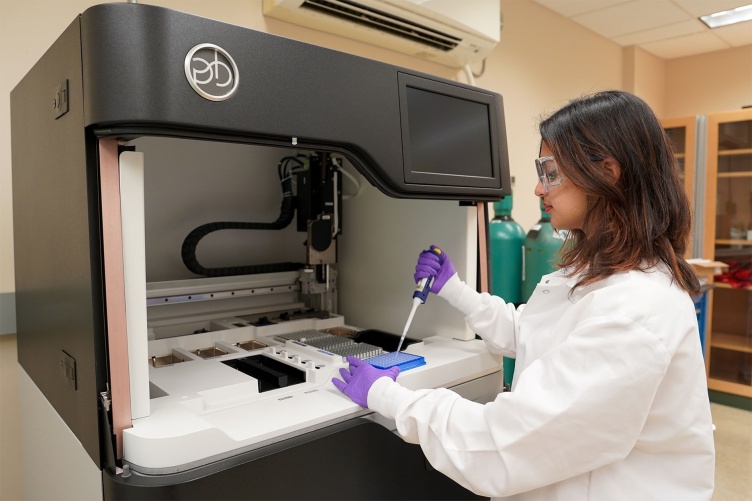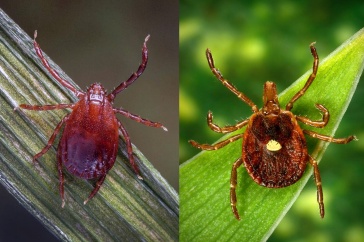
Disha Hegde, a Bachelor of Science in Genetics student at COLSA, uses the PacBio Sequel lle system at the Hubbard Center for Genome Studies.
Thanks to the addition of two new instruments, a PacBio Sequel lle system and a Nanopore GridION, the UNH Hubbard Center for Genome Studies (HCGS), and its partner the Collaborative Core Wet Lab, can now sequence much longer DNA fragments, which will allow for greater accuracy and broader applications—especially when working with plants and microorganisms. Until recently, the HCGS’ services have been based on short-read sequencing of genomes—the genetic instructions found within all living organisms—which requires breaking the genetic material into small fragments or chunks before they are sequenced. These new long-read sequencing services will become available to organizations both internal and external to the University of New Hampshire in early 2024.
Enhancing Genomic Studies with New Technology
Both short- and long-read sequencing are types of DNA and RNA sequencing. However, where short-read sequencing is generally less costly, quicker, more widely available and can capture most genetic variations among genome structures, long-read sequencing allows for the detection of complex structural differences among genomes.
“With the short-read sequencing, we’re able to do a lot and support a number of projects,” explained W. Kelley Thomas, director of the HCGS and a professor of molecular, cellular and biomedical sciences at UNH. “Instead of sequencing hundreds of nucleotides in strings, the longer-read sequences will consist of thousands of nucleotides, sometimes tens of thousands, and we’ll be able to better identify the kinds of variation that require those longer strands.”
Applications and Implications in Agriculture and Pathogen Study
For example, the long-read sequencing will allow for more accurate assembly of large genomes such as those of agricultural plants, facilitating identification of meaningful genetic differences among agricultural crop varieties and the connection of specific genes with traits of interest to farmers and/or consumers.
“Long-read sequencing is important for providing complete information on emerging pathogens...You can look at it in pieces, but to get the entire picture it helps to have long-read sequencing.” ~ W. Kelley Thomas, professor of Molecular, Cellular, and Biomedical Sciences
According to Tom Davis, a professor emeritus of plant biology and genetics, he and his research team at UNH have depended on long-read sequencing from organizations outside the university for work in strawberry and quinoa genetics.
“We are extremely excited by the addition of these new DNA sequencing technologies to the UNH HCGS repertoire,” added Davis. "Having in-house, long read sequencing services at the HCGS will allow us to move much more quickly and economically in acquiring the immensely informative data sets that result from the cutting-edge PacBio and Nanopore technologies.”
Long-read sequencing will also allow for greater application in studying microorganisms, like bacteria, and pathogenic microbes.
“Long-read sequencing is important for providing complete information on emerging pathogens,” added W. Kelley Thomas. “Even SARS-CoV-2 — the virus that causes COVID — is tens of thousands of nucleotides long. You can look at it in pieces, but to get the entire picture it helps to have long-read sequencing.”
According to Iago Hale, associate professor of sustainable agriculture and food systems at UNH, long-read sequencing services available through the HCGS will support his work with neglected and under-researched crops.
“There is generally a lack of genomic resources available for these crop types, and that information is necessary for implementing modern breeding methods,” explained Hale. “With these new instruments, it’s now within reach to develop such genomic resources in house, taking us from 0 to 60 within a season.”
The addition of the HCGS’s two new long-read sequencers and other instruments were made possible through a federal appropriation secured by Sen. Jeanne Shaheen in 2022. The $1.9 million earmark supports the purchase of new equipment at UNH to improve the university’s capabilities in testing, surveilling and sequencing pathogenic threats. And those pathogenic threats are not just human pathogens, added Thomas.
“We also need to be thinking about and monitoring for food pathogens and threats to our food security,” Thomas said. “Whether it’s human health, plant health, animal health or environmental health, genomics plays a powerful role in that.”
Want to learn more about these and other services available from the HCGS? Visit the Hubbard Center's services webpage or email unh.hcgs@unh.edu for more information. Services webpage will be updated with long-read sequencing services information as it becomes available.
-
Written By:
Nicholas Gosling '06 | COLSA/NH Agricultural Experiment Station | nicholas.gosling@unh.edu



















































